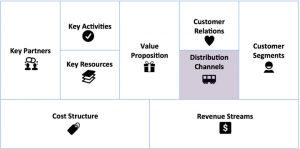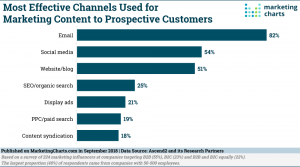
05 Aug On Startups: How to Build Valuable Distribution Channels and Lasting Customer Relationships
“There is only one boss. The customer. And he can fire everybody in the company from the chairman on down, simply by spending his money somewhere else.” – Sam Walton
 In 2008, Alexander Osterwalder, business theorist, consultant, and co-founder of Strategyzer, released a simple 9-step template he called the “Business Model Canvas”. This tool was created to assist entrepreneurs and business owners in breaking down their ventures into smaller, easier to understand segments, the idea being that each segment can be honed in on, tweaked, and improved significantly by utilizing the canvas.
In 2008, Alexander Osterwalder, business theorist, consultant, and co-founder of Strategyzer, released a simple 9-step template he called the “Business Model Canvas”. This tool was created to assist entrepreneurs and business owners in breaking down their ventures into smaller, easier to understand segments, the idea being that each segment can be honed in on, tweaked, and improved significantly by utilizing the canvas.
In reference to the quote above, you’ve definitely heard something similar before – the customer is always right. Your customers, especially in the startup stages of your venture, are the lifeblood of the business that you’re working to build. Without their support you’re as good as gone, so it’s critical that you put thought into how you can best reach your customers and how you can continually engage with them. In a competitive market, building this relationship as their trusted provider of products and services can be a defining factor in whether or not you come out on top.
In this article we’ll review two critical segments of the tool – distribution channels and customer relationships. After reading, you should have a better idea of how you can use Osterwalder’s canvas to create and/or improve these areas in your own business model. (img source)
This is the second article in a series of posts about Osterwalder’s Business Model Canvas. This article will build off of some previously discussed material found in the first post, so for a more complete understanding of the topic, be sure to start from the beginning.
Distribution Channels
Your channels, or distribution channels, describe the manner in which your company initially reaches out to your customer segments to deliver your value proposition. Some companies only use one channel, while others use multiple – it ultimately depends on the makeup of your customer base and the forms of media they’re most likely to engage with.
Take a second to think about the company you work for – how many different channels does your company use to contact your customers?
In the chart below you’ll notice the most common and effective channels businesses use to interact with prospective customers. Even today, email marketing is by far the most effective means of marketing your product to your audience; a recent study found that this form of marketing is up to 40 times more effective than social media, and that customer’s buying process happens 3x faster when compared to purchases made through social media.
While email marketing is generally a safe bet due to it’s cost-effectiveness, customizability, and measurability, that doesn’t mean it should be the only channel you use to reach your customer segments.
 Your choice of additional channels should be influenced by your answers to the following questions:
Your choice of additional channels should be influenced by your answers to the following questions:
Which channels do your customers want to be reached through? Conduct surveys and polls to determine what channels your customers prefer using to communicate with your business.
Which channels are the most effective? Determine the effectiveness of your marketing campaigns by monitoring and recording engagement rates, click-through-rates, likes & shares, impressions, comments, and other related criteria, then compare. Avoid paying for channels that your audience doesn’t engage with.
Which channels are the most cost-effective for your business? Marketing your product to your customer base can get expensive – in 2018, pay-per-click campaigns cost the average small business 9 – 10k a month. As such, this is the question you’ll likely have to pay a great deal of mind to. What channels can you afford to develop without breaking the bank? (img source)
Customer Relationships
As we mentioned earlier, building relationships with your customers is arguably the most crucial aspect of any venture – without them your business won’t be competing in the market for long. While channels describe the avenues you use to initially interact with your customers, the customer relationships segment of the Business Model Canvas describes how your interactions develop after that first touch point.![]()
Depending upon your industry and the product or services you’re offering, there are a few things you should consider:
Will your interactions with customers be frequent or infrequent?
Are you aiming for a short-term relationship or a long-term relationship with your customers?
Do your customers need to speak with an actual person to purchase your product or services, or can they use some form of technology?
Will you have to focus more on acquiring new customers or retaining old ones in order to grow your customer base?
After determining what approaches will work most effectively for building strong, long-lasting relationships with your customers, you’ll have to decide which type of service your company will offer. The type of service you’re able to offer is largely decided by the product or services your company provides. (img source)
The most common types of customer relationships are listed below according to Focus Framework’s analysis:
Personal service: you and your employees serve customers your product directly. ex: you open a restaurant and prepare and serve meals right to your customers
Self-service: customers primarily serve themselves your product without needing to interact with your company. ex: if you want to buy Avengers on DVD, you don’t need to contact or interact with Marvel Studios in any capacity to receive their product
Automated: customized service is offered via automated processes. ex: an ATM offers services and assistance to customers of the bank, but no human interaction from the business’s side is required
Companies that remain competitive in the market map out these interactions, measuring their effectiveness at convincing customers to buy or continue using their services along the way. Remember, your ability to foster relationships with your customers is one of the most critical aspects of building a successful venture, so focus on developing your distribution channels and customer relationships to become the trusted provider of products and services your customers need.
Check back in next Monday to continue learning about the remaining segments of the Business Model Canvas. In the meantime, we’ve got plenty of great content on our blog – check it out here.
What channel or channels do you prefer to use while interacting with new companies for the first time? Leave a comment on our LinkedIn or Facebook pages letting us know what you think!
——————————————————————————————————————————————————————————————————–
If you’re in search of recruiting services or could use help determining your business needs, contact our team of experienced talent acquisition consultants now.


